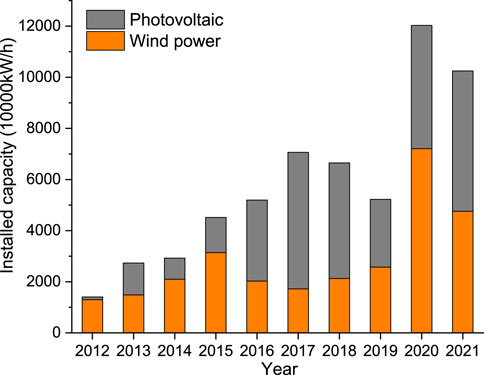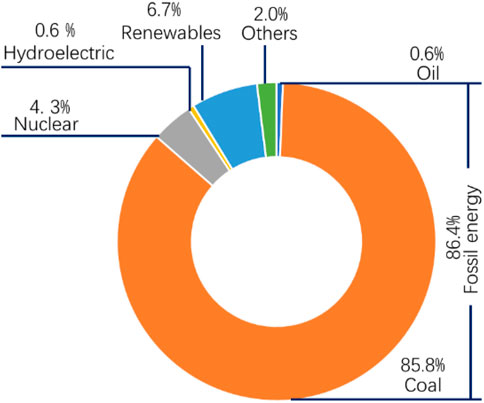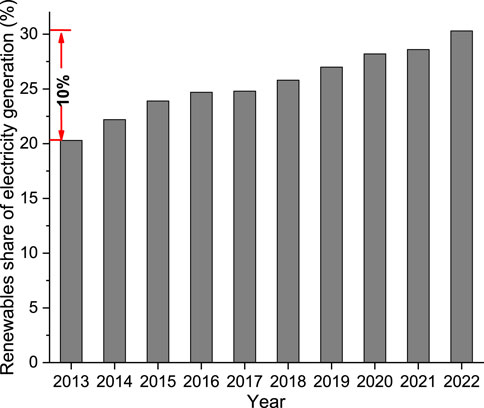- 1Division of Asian and African Affairs, China Science and Technology Exchange Center, Beijing, China
- 2School of Thermal Engineering, Shandong Jianzhu University, Jinan, China
- 3Business School, Shandong Jianzhu University, Jinan, China
South Africa possesses extremely rich renewable energy resources, including solar energy and wind energy, in spite of this, South Africa traditionally relies on coal as its primary energy source. Recently, South Africa confronted with severe electricity shortage. With pressure of power shortage and the transition to low-carbon energy, South Africa has been actively promoting the development of renewable energy, aiming to diversify its energy structure. China, as the world’s leading country in the development and utilization of renewable energy, has long been committed to helping South Africa achieve renewable energy development. This article reviews the cooperation progress between China and South Africa in renewable energy, and provides an in-depth analysis of the challenges currently faced by both sides. To address such challenges, it is suggested to strengthen the design of top-level cooperation mechanisms, create diverse collaboration platforms, prioritize the exchange and collaboration of scientific talents. This paper aims to provide a typical reference for deepening renewable energy cooperation between China and South Africa.
1 Introduction
After the Second Industrial Revolution, the global economy experienced rapid growth, accompanied by a significant consumption of fossil fuels. As a result, the dramatic increase in greenhouse gas emissions, primarily carbon dioxide, has led to global climate warming. In response to this environmental crisis, global is actively exploring pathways toward low-carbon development (Fan et al., 2023).
South Africa and China possess similar endowments of energy resources (Figure 1), with both predominantly relying on coal as primary energy source. In particular, the coal consumption of South Africa accounts for an impressive 71% (2021) (Statistical Review of World Energy, 2022), this highlights a common need for both nations in the transition towards to green and low-carbon alternatives. In September 2020, China solemnly declared its commitment at the 75th United Nations General Assembly to peak carbon dioxide emissions before 2030 and strive for carbon neutrality by 2060. In March 2021, South Africa’s “National Determined Contributions” outlined its plan to peak carbon emissions by 2025 and achieve carbon neutrality by 2050 (Bekun, 2024).
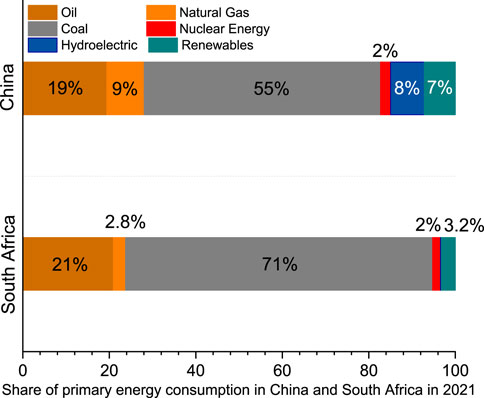
Figure 1. Share of primary energy consumption in China and South Africa in 2021 (Statistical Review of World Energy, 2022).
Vigorously developing renewable energy such as wind energy, solar energy, etc., is crucial to overcome the limitation of fossil fuel shortage and high carbon emission in grasping the high-quality development. For this, China has set forth the goal that the proportion of non-fossil energy in primary energy consumption will reach 25% by 2030, thereinto, the total installed capacity of photovoltaic and wind power generation will exceed 1.2 billion kilowatts. With that, China has achieved rapid development of renewable energy industry, thus pioneering the establishment of a comprehensive industry chain. This chain covers upstream of raw materials, midstream of renewable energy equipment, and downstream of renewable energy application.
Since 2008, South Africa has been perplexed with electricity shortages. On 9 February 2023, the President of South Africa declared a “state of disaster” due to electricity shortages. According to statistics from the South African Reserve Bank, South Africa incurred an economic loss of $51 million per day on average in 2023 due to power outages (Bekun, 2024). This lies in the relatively single structure of South Africa’s power supply, which is heavily depended on coal for electricity generation.
For all this, South Africa has abundant solar energy and wind energy resources. Taking solar energy as an example, Johannesburg, Cape Town, Bloemfontein, and Pretoria of South Africa experience an annual average sunshine duration over 2,500 h. Such solar radiation is nearly 40% higher than that of Europe. In addition, South Africa also sets target for carbon peak and carbon neutrality via “National Determined Contributions,” it is aimed to raise the proportion of solar and wind power, which is expected to be increased from the current 7%–40% by 2030. Except for wind energy and solar energy, hydroelectric energy and biomass energy are also expected to potential electricity sources, the installed capacity would be increased to 2545 MW and 313 MW in 2030, respectively (Skosana et al., 2023). However, the wind power and photovoltaic industries in South Africa are still in early development stage, which has tremendous potential for development (Thopil et al., 2018). In comparison, China has emerged as the world’s leading in renewable energy. The total installed capacity of renewable energy of China accounts for approximately one-third of the global market in 2021. As depicted in Figure 2, the photovoltaic electricity installed capacity in 2021 increases 51-fold compared with that of 2012, which is surged from 1.07 million kilowatt to 54.93 million kilowatt. The installed capacity of wind power shows consistent growth, which is newly installed 47.57 million kilowatt (Wang and Xiaoli, 2023). Newly released data shows that, as of June 2023, China’s installed capacity of wind power reached 389 million kilowatts and the photovoltaic electricity reached 470 million kilowatts (Xinhua News Agency, 2023).
China and South Africa have established diplomatic relations for 26 years, in past 14 years, South Africa has always been China’s largest trading partner in Africa. Energy is the key area for cooperation between China and South Africa, such cooperation enhances South Africa’s accessibility to electricity and promotes the sustainable development of both sides.
2 Necessity and significance of cooperation
2.1 Assisting South Africa in addressing electricity crisis
The economic development of South Africa has been consistently plagued by electricity shortages since 2008. As depicted in Figure 3, the electricity supply heavily relies on coal, which accounts for over 85%. Meanwhile, the incremental growth of renewable energy generation is unable to meet the short-term increase in electricity consumption. This leads to power supply crisis in South Africa. According to statistics, the duration of power outages in South Africa increased from 852 h in 2015 to 1,169 h in 2021. This has resulted in an average annual reduction of 1%–1.3% in the gross domestic product (GDP), even with a substantial decrease of around 5% in 2022 (Tsinghua University Institute of International and Regional Studies, 2023). It is presumably due to the single reliance on coal of the electricity energy structure, this renders the electricity system of South Africa is vulnerable to risk.
In comparison, China has successfully undergone the optimization and transformation of power energy structure. Over the decade from 2013 to 2022 (International Energy Agency, 2024), the proportion of renewable energy (photovoltaic and wind power) is increased from 20.3% to 30.3% with growth of 10% (Figure 4). This not only optimizes the structure of power energy, also enhances the reliability of power supply. Furthermore, the substantial utilization of renewable energy significantly reduces carbon emissions, which laid a solid foundation for China to achieve carbon neutrality. This also provides a feasible reference path for South Africa in achieving carbon neutrality. Therefore, cooperation between China and South Africa in renewable energy could ensure a stable supply of electricity for South Africa.
2.2 Promoting sustainable development in South Africa
Excessive reliance on coal usage of South Africa results in a mass of CO2 emission, aggravating the greenhouse effect. As shown in Figure 5, the average temperature increase in South Africa is higher than the global average temperature increases since 1980 (Tao et al., 2020). The rising temperature exerts severe impacts on agriculture and tourism of South Africa.
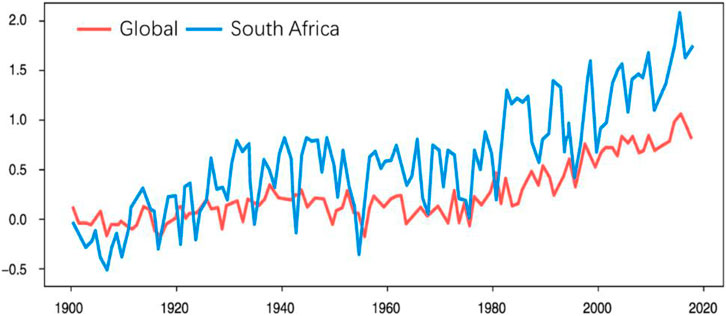
Figure 5. The average temperature variation in South Africa from 1900 to 2020 (Source: Piotr Wokki. Twice the Global Rate CSAG of Cape Town University).
As a crucial part of the South African economy, the tourism industry contributes approximately 3% to the GDP. However, the tourism resources are currently being impacted by changes in temperature. Firstly, coastal cities, which heavily rely on beach tourism, are facing adverse effects due to rising sea levels, posing a threat to the development of tourism. Secondly, the biodiversity of South Africa’s tourism resources is under serious threat. Currently, climate change has pushed several hundred animal species in South Africa to the brink of extinction, including rare species such as the African penguin, vervet monkey, African wild dog, and South African vulture. Biodiversity, as a crucial resource for South African tourism, is facing significant challenges thus threatening the tourism development. Increasing the utilization of renewable energy and lowering carbon emissions can strongly contribute to the sustainable development of the South African economy.
Besides, the coal-fired power plants under South Africa’s largest electricity company, Eskom, emitted 211.1 million tons of CO2 in 2017 (Table 1). In addition, acid pollutants like SO2 and NOx discharged 1.766 and 0.885 million tons, respectively. PM10, the chief culprit of hazy weather, reached 65,130 tons. Carbon dioxide (CO2) is the key greenhouse gas (GHG) contributing to environmental pollution and global warming. As depicted in Figure 6, the CO2 emission of South Africa is always over 500 million tons in past decade, this not only poses a threat to public health also severely contaminates air quality, thus dealing a significant blow to the tourism industry.
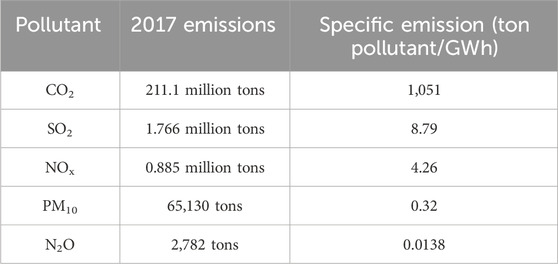
Table 1. Eskom’s coal plant air emissions 2017 (Eskom Hld and SOC Ltd, 2017).

Figure 6. CO2 emission of South Africa from 2013–2022 (Jones et al., 2023)
2.3 Strong complementarity between urgent demand and advanced technology
South Africa is located at the southernmost tip of Africa, with a coastline stretching over 2,500 km. The inland regions of South Africa consist of flat plateaus with elevations ranging from 1,000 m to 2,100 m. The solar energy of South Africa is exceptionally abundant (Figure 7), with an annual average sunshine duration exceeding 2,500 h. The daily average solar radiation ranges between 4.5 and 6.5 kWh/m2 (Thopil et al., 2018), thus providing excellent conditions for the development of solar photovoltaic electricity generation.
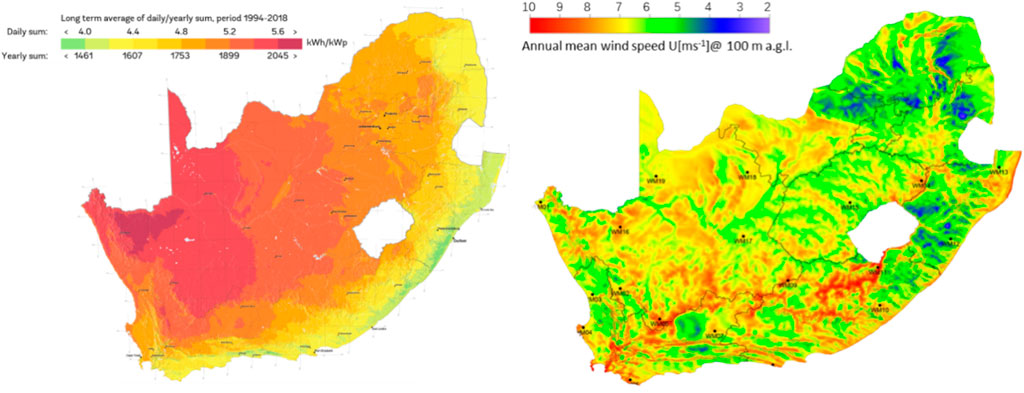
Figure 7. Solar energy and wind energy map of South Africa (Sources: Solar energy map is from the World Bank Group; Wind energy map is from South African Wind Energy Association).
Sources: Solar energy map is from the World Bank Group; Wind energy map is from South African Wind Energy Association.
Not only the solar energy, South Africa also has tremendous wind energy. It is estimated that over 80% territory of South Africa possesses suitable natural conditions for wind power development, especially along the eastern and southern coastal areas (Figure 7). Regions such as Western Cape Province, Eastern Cape Province, and Northern Cape Province have relatively richer wind energy resources, with annual average wind speed usually exceeding 5 m/s, which is supposed to be the preferred locations for wind electricity generation (Whelan and Muchapondwa, 2011). Despite the abundance of renewable resources, the installed capacity of photovoltaic and wind power in South Africa accounts for only 6.7% of the overall energy as of 2021 (Statistical Review of World Energy, 2022). This is significantly below South Africa’s target of achieving 40% of renewable energy power generation capacity.
China has mature energy generation technology and hold large market share. For instance, the wind power critical components of China account for over 70% of the global market. Meanwhile, the robust supply chain system and manufacturing infrastructure enable Chinese enterprises could offer renewable energy products with lower prices. Taking the example of solar modules priced in December 2023, China’s cost stands at $0.15 per watt, significantly lower than India ($0.22 per watt), Europe ($0.30 per watt), and the United States ($0.40 per watt).
Therefore, cooperation between South Africa and China in renewable energy not only enhances the value of South Africa’s natural resources, upgrades its power energy structure, and changes the current power shortage situation in South Africa but also effectively drives local infrastructure construction. For Chinese enterprises, the collaboration can bring substantial economic benefits and increase national foreign exchange income. Furthermore, China provides financing and incentive support to renewable energy enterprises, which not only helps enterprises overcome risk premiums and safeguard their benefits but also solves the problem of project financing difficulties in South Africa. This provides ample assurance for cooperation between China and South Africa in renewable energy.
3 Current status of renewable energy cooperation between China-South Africa
3.1 Foundation of cooperation and policy
As one of the world’s largest greenhouse gas emitters, South African government has consistently pursued a low-carbon renewable energy transformation, a series of policies concerning the development of renewable energy are implemented (Figure 8) (Zheng et al., 2023). As early as 2003, South Africa released the “Renewable Energy White Paper,” aiming to increase the annual renewable energy generation to 10,000 GkW/h within a decade. In September 2019, South Africa officially enacted the “Carbon Tax Act,” becoming the first African country to implement a carbon tax. In April 2020, South Africa unveiled the “Low Carbon Emission Development Strategy,” outlining a “Peak-Stabilize-Decline” carbon emission reduction path. In 2021, the draft of the “National Determined Contributions” was published, setting targets for carbon peak and carbon neutrality. South Africa aims to raise the proportion of solar and wind power, which is expected to increase from the current 7%–40% by 2030 (Zou, 2023).
China has been committed to cooperation with South Africa in the field of energy. As early as 2010, the two countries signed a “Memorandum of Understanding on Energy Cooperation,” marking the comprehensive initiation of their energy collaboration. With deepening of the Belt and Road Initiative, China signed a series of agreements with African countries, including South Africa, to support renewable energy cooperation (Chen and Yanjie, 2023). In 2015, during the Johannesburg Summit of the Forum on China-Africa Cooperation (FOCAC), China introduced the “Ten Cooperation Plans,” pledging support for the implementation of 100 clean energy projects in Africa. This initiative involved collaboration on solar energy, wind energy, biogas, hydropower, and clean stoves, contributing to the sustainable development. In December of the same year, China and South Africa signed the “Memorandum of Understanding between the Government of China and South Africa on Jointly Promoting the Construction of the Silk Road Economic Belt and the 21st Century Maritime Silk Road.”
In 2021, the FOCAC Dakar Action Plan emphasized the need to increase the share of clean energy, gradually address energy accessibility issues, and promote sustainable energy development for both parties. In June 2023, China and South Africa jointly organized a New Energy Investment Cooperation Conference, where over 170 Chinese companies and local South African enterprises achieved fruitful results in expanding their cooperation in renewable energy investments (Embassy of the Peoples, 2023). This collaboration is instrumental in helping South Africa address its power crisis.
It is evident that the South African government possesses a strong commitment to promoting the development of renewable energy. The series of cooperation agreements reached between China and South Africa serve as a solid foundation, providing assurance and support for their collaborative efforts.
3.2 Scientific research level cooperation
Technological innovation is a crucial driving force behind the advancement of energy, both China and South Africa emphasize the role of technology empowerment in their cooperation on renewable energy. The two countries have engaged in various levels of technological cooperation and exchanges (Liu, 2022). For instance, adhering to the principle of mutual benefit, China and South Africa have initiated key collaborative projects under the “Government-to-Government International Science and Technology Innovation Cooperation,” involving joint funding for collaborative research and development. This initiative aims to promote the exchange of technology professionals, collaborative demonstrations, and encourage the open sharing of large-scale research infrastructure. Through such efforts, both countries seek to address energy innovation challenges together.
The National Natural Science Foundation of China (NSFC), as the main channel for funding basic research, operates on the principles of equal cooperation, mutual benefit, and shared outcomes. Under the framework of the BRICS STI (Science, Technology, and Innovation) Framework Programme, NSFC has entered into an agreement with the National Research Foundation of South Africa (NRF) to jointly fund collaborative research projects. This agreement aims to support scientists in grounding their work in international scientific frontiers, effectively utilizing global scientific resources, creating cooperative opportunities, fostering close collaborative ties, and engaging in substantial international collaborative research and academic exchanges.
In addition to joint research on renewable energy, there are civil technology cooperation platforms, such as the China-Africa Innovation Cooperation Center. These platforms initiate China-Africa Innovation Cooperation and Development Forum, and the China-Africa Partner Research Institute Exchange Program. They serve as bridges of communication for research institutions, enterprises, and other entities engaged in the development of renewable energy between China and South Africa.
It is worth mentioning that the cooperation initiated by universities. Energy collaboration among universities between China and South Africa, not only allows for the high degree of flexibility, also enhances the role of technological empowerment. For instance, Hebei University of Science and Technology has jointly established New Energy International Collaborative Laboratory with University of South Africa, which is devoted to conducting in-depth research in biomass utilization, carbon dioxide chemical storage, fuel ethanol, and hydrogen energy. Tsinghua University and Shanghai Jiaotong University assisted South Africa training 50 engineering technicians those involved in civil nuclear energy.
3.3 Technological and industrial level cooperation
Under the strong support of policies from both China and South Africa, Chinese companies have made significant contributions to promote the development of renewable energy in South Africa (Table 2). Goldwind Sci and Tech Co. Ltd., as a global leading wind turbine manufacturer and operator, responded to the call of the national “Belt and Road” initiative and entered the South African market in 2015. It has successfully completed and operated two wind power projects in Eastern Cape Province, with a total installed capacity of 152.5 MW. Each year, these projects deliver green and clean electricity to approximately 155,000 households in South Africa.
The first Build-Operate-Own integrated wind power project undertaken by Chinese company in South Africa, the De Aar Wind Power Project in the Northern Cape Province, began generating power in 2017. With a total installed capacity of 244,500 kW, the project can reliably supply approximately 760 million kilowatt-hours of clean electricity annually. This alleviates the electricity shortage and improves the local ecological environment.
The Hongshi 100 MW Tower Concentrated Solar Power Project, constructed by SEPCOII Electric Power Construction Co. Ltd., is the first tower-type concentrated solar power project south of the Sahara in Africa. This cutting-edge solar project, with a designed capacity of 100 MW, is expected to deliver 480 GW-hours of electricity annually, meeting the power needs of 200,000 households in South Africa. Not only does it effectively alleviate South Africa’s power shortages, but it also serves as another example of deepening energy cooperation between China and South Africa. The project has provided over 600 direct employment opportunities for the local community, with 1,800 workers employed during the peak construction period. It has made a significant contribution to the local economic and social development.
China and South Africa have achieved fruitful results in their cooperation on renewable energy and are poised to become new growth points and highlights in the economic and trade collaboration between the two countries. This is attributed to the shared developmental needs and strong complementary advantages that China and South Africa possess in the field of new energy. They can serve as reliable friends and strong partners for each other in the economic and social transformation and development.
4 Challenges in renewable energy cooperation
The evolving international landscape presents new challenges for China-South Africa cooperation in renewable energy.
4.1 Impact of the international situation
As a leading country in renewable energy development in Africa, South Africa faces intense international competition in energy investment. Western countries, leveraging their significant political, economic, and cultural influence, hold a dominant position in aspects of technical standards and financing efficiency. Chinese enterprises often encounter challenges in securing advantageous resources and high-quality projects, requiring investments that surpass those of Western counterparts. Additionally, Western nations grasp the discourse power and climate governance, influencing international standards for renewable energy technology, supply-demand structures, and investment trends. These competitions pose certain challenges to the collaboration between China and South Africa in renewable energy. Moreover, the impact of the COVID-19 pandemic has led to project stoppages or delays, disrupting supply chains and logistics, rising labor and material costs, and affecting the development of renewable energy (African Development Bank Group, 2022).
4.2 Impact of the domestic situation in South Africa
South Africa has long relied on fossil energy, primarily coal, for economic development. The crucial challenge in renewable energy lies in overcoming domestic political and economic transition barriers. Additionally, it is essential to ensure adequate and fair support for businesses and workers dependent on fossil fuel income through compensation and skill diversification programs. In fact, it lacks of sustained and stable implementation of South Africa’s renewable energy policy. For instance, certain renewable energy power purchase agreements are not being enforced, posing significant risks for Chinese companies investing in renewable energy projects in South Africa. Furthermore, the expertise in renewable energy domestically creates uncertainties in later project operation, making it challenge to guarantee the anticipated economic benefits. Similar to many other African countries, the transmission and distribution networks of South Africa cannot handle large-scale integration of renewable energy generation, the outdated power infrastructure acting as a bottleneck restricts the development of renewable energy in South Africa.
4.3 Insufficient depth and level of cooperation
Currently, the collaboration between China and South Africa’s in renewable energy is primarily led by government, the involvement of civil society forces is limited. Although some Chinese companies have entered the South African energy market, their development has not been substantial enough to establish a competitive advantage. In particular, there is a lack of mature collaboration model of both countries, and the direct and effective communication channels is deficient. For instance, the youth scientist exchange program has been implemented between China and South Africa. Moreover, the ongoing efforts are devoted to deepening short-term exchanges and technical personnel training between the two sides. However, the youth exchanges in energy field are not sufficient, and technical exchanges are not closely connected. South Africa is more engaged in exchanges with Western countries, and there are still certain trust issues in understanding technology. This impedes the cooperation in renewable energy between two sides.
Furthermore, the exchange and collaboration between civil organizations and other social forces in both countries are relatively lagging. Renewable energy development is a comprehensive project that requires holistic planning and coordinated efforts.
5 Recommendations for achieving win-win cooperation
Although the renewable energy collaboration between China and South Africa faces various challenges, there are still many opportunities from the long-term perspectives, several suggestions are given to make forward deepen cooperation.
5.1 Innovating mechanism for renewable energy cooperation
The utilization of renewable energy encompasses various stages, including energy conversion, storage, transportation, and supply. These stages are highly dependent on equipment and technology, and the absence of any stage would limit the efficiency of renewable energy. Therefore, China is expected to gain in-depth understanding the needs and strategies for renewable energy development of South Africa. For instance, as China provides strategic planning assistance and technical support for South Africa, the grid transformation, power complementarity, and large-scale energy storage equipment are expected to be considered at the same time. Furthermore, the following actions are suggested: participating in the top-level structure design of multilateral renewable energy project is essential; establishing a priority list for renewable energy cooperation; accelerating the internationalization of the new standards derived from the energy cooperation between China and South Africa; intensifying the joint research and demonstration project construction in the renewable energy via considering the shared goals of the bilateral governments. Moreover, safeguarding the interests for the private energy enterprises in South Africa is critical, with that, the “sustainable development benefit chain” between China-South Africa on renewable energy cooperation could be defined and used to address the practical needs of South Africa.
5.2 Establishing diversified cooperation platform
Renewable energy has characteristics of variability and periodicity, its efficient utilization involves various industries, the current renewable energy industry chain in South Africa is not fully developed. To address these, firstly, it is essential to strengthen the scientific cooperation in energy field between universities in China and South Africa, enhance academic exchanges, and promote the construction of platform for basic research cooperation. Secondly, it is urgent to construct the collaborative platform for renewable energy industry, which should be guided by government policies, supported by technological cooperation, and led by market orientation, thus improving the collaboration efficiency. Thirdly, it is ought to encourage cooperation among enterprises, coordinate the development of upstream/downstream industries, promote full-chain collaboration, and support the establishment of technology training platforms and financing platforms.
5.3 Enhancing cultivation of technological talents
China, in promoting its own “green energy revolution,” has accumulated wealth experience of the advanced technologies with independent intellectual property right. Technological talent is the key for China promoting the development of renewable energy in South Africa. Therefore, it is imperative to facilitate the exchange of scientific and technological talent for both China and South Africa in renewable energy cooperation. For instance, establishing special funds for South African technological talents, promoting two-way flows of scientific talents between China and South Africa, especially in the exchange of young scientists. Moreover, considering the importance of skill enhancement for engineers, technicians, and other workforce in the development of renewable energy, efforts should be made to promote technical training jointly undertaken by the government and businesses. Only in this way, it could fully take advantage of scientific and technological talents in renewable energy transformation of South Africa.
6 Conclusion
The diversification and decarbonization of energy supply are an inevitable trend worldwide. A new round of renewable energy revolution, marked by low carbon, is already underway. The number of countries considering the development of renewable energy as a crucial component in increasing. Through the collaborative model between China and South Africa, it could create a successful paradigm and establish new and suitable energy standards for African development, wherein in South Africa serves as the main body. This would provide guide for the rapid and healthy development of renewable energy across the entire African continent.
Author contributions
XY: Conceptualization, Writing–original draft. XT: Conceptualization, Investigation, Supervision, Writing–review and editing. HL: Data curation, Methodology, Writing–original draft. HG: Investigation, Writing–original draft.
Funding
The author(s) declare that financial support was received for the research, authorship, and/or publication of this article. This work is supported by Research on the Path of Deep Participation of Shandong in the “Belt and Road” Scientific and Technological Innovation Cooperation in the New Era (2023RZA05002).
Conflict of interest
The authors declare that the research was conducted in the absence of any commercial or financial relationships that could be construed as a potential conflict of interest.
Publisher’s note
All claims expressed in this article are solely those of the authors and do not necessarily represent those of their affiliated organizations, or those of the publisher, the editors and the reviewers. Any product that may be evaluated in this article, or claim that may be made by its manufacturer, is not guaranteed or endorsed by the publisher.
References
African Development Bank Group (2022). Africa economy outlook (2022-07-20). Available at: https://www.afdb.org/en/knowledge/publications/african-economic-outlook.
Bekun, F. (2024). Race to carbon neutrality in South Africa: what role does environmental technological innovation play? Appl. Energy 354, 122212. doi:10.1016/j.apenergy.2023.122212
Bloomberg News (2023). Blackouts may cost South Africa $51 million a day, central bank says. Investing. Available at: https://www.bnnbloomberg.ca/blackouts-may-cost-south-africa-51-million-a-day-central-bank-says-1.1879989.
Chen, C., and Yanjie, Li (2023). Challenges and suggestions for deepening sino-african clean energy cooperation at present. Hydropower 49 (04), 87–90.
Embassy of the Peoples (2023). China-South Africa new energy investment and cooperation conference successfully held. People's Dly. Online. Available at: http://world.people.com.cn/n1/2023/0614/c1002-40013163.html.
Eskom Hld SOC Ltd (2017). Eskom integrated report. Available at: http://www.eskom.co.za/IR2017/Documents/Eskom_integrated_report_2017.pdf.
Fan, S., Zhang, Y., Cui, L., Maqsood, T., and Nižetić, S. (2023). Cleaner production of aviation oil from microwave-assisted pyrolysis of plastic wastes. J. Clean. Prod. 390, 136102. doi:10.1016/j.jclepro.2023.136102
International Energy Agency (2024). What is the role of renewables in electricity generation in China? Available at: https://www.iea.org/countries/china/renewables.
Jones, M. W., Peters, G. P., Gasser, T., Andrew, R. M., Schwingshackl, C., Gütschow, J., et al. (2023). National contributions to climate change due to historical emissions of carbon dioxide, methane, and nitrous oxide since 1850. Sci. Data 10 (1), 155. doi:10.1038/s41597-023-02041-1
Liu, G. (2022). Historical evolution and practical paths of science and technology cooperation between China and africa in the context of the "Belt and Road" initiative. J. Xiangtan Univ. 46 (05), 28–33. doi:10.13715/j.cnki.jxupss.2022.05.018
Skosana, B., Siti, M. W., Mbungu, N. T., Kumar, S., and Mulumba, W. (2023). An evaluation of potential strategies in renewable energy systems and their importance for South Africa-A review. Energies 16 (22), 7622. doi:10.3390/en16227622
Statistical Review of World Energy (2022) Statistical review of world energy. London, UK: BP p.l.c., 8–10.
Tao, Li, Jiao, P., and Wang, D. (2020). Research on the countermeasures of the South African government and financial system in dealing with climate change risks. Int. Finance (06), 74–80. doi:10.16474/j.cnki.1673-8489.2020.06.011
Thopil, M., Bansal, R., Zhang, L., and Sharma, G. (2018). A review of grid connected distributed generation using renewable energy sources in South Africa. Energy Strategy Rev. 21, 88–97. doi:10.1016/j.esr.2018.05.001
Tsinghua University Institute of International and Regional Studies (2023). Dark ages in South Africa: when power supply becomes a national disaster. Eurasian system science research association. Available at: https://www.essra.org.cn/view-1000-5164.aspx.
Wang, X., and Xiaoli, C. (2023). Analysis of the situation of China's power development and reform. China Power Netw. Available at: http://mm.chinapower.com.cn/zx/zxbg/20230330/194622.html.
Whelan, B., and Muchapondwa, E. (2011). Enhancing consumers' voluntary use of small-scale wind turbines to generate their own electricity in South Africa. J. Energy South. Afr. 22 (2), 13–21. doi:10.17159/2413-3051/2011/v22i2a3210
Xinhua News Agency (2023). How China's photovoltaic and wind power industry leads the world - insight into China's high-quality development Part Three. China Gov. Website. Available at: https://www.gov.cn/yaowen/liebiao/202308/content_6899173.html.
Zheng, H., Wang, H., Wang, J., et al. (2023). BRICS countries' climate policies, energy structures, and carbon emissions towards carbon neutrality. China Popul. Resour. Environ. 33 (6), 67–79.
Zou, S. (2023). Jointly building "Belt and Road" green cooperation to help South Africa accelerate energy transition. China Belt and Road portal. Available at: https://www.yidaiyilu.gov.cn/p/0P4MIODL.html.
Keywords: renewable energy, cooperation between China and South Africa, scientific exchange, energy structure, low-carbon transition
Citation: Yan X, Tian X, Li H and Guo H (2024) Research on technical cooperation path of renewable energy between China and South Africa. Front. Energy Res. 12:1411546. doi: 10.3389/fenrg.2024.1411546
Received: 03 April 2024; Accepted: 26 April 2024;
Published: 10 May 2024.
Edited by:
Yaning Zhang, Harbin Institute of Technology, ChinaReviewed by:
Muhammad Mubashar Omar, University of Agriculture, Faisalabad, PakistanLiangliang Fan, Nanchang University, China
Mengbin Li, University of Birmingham, United Kingdom
Copyright © 2024 Yan, Tian, Li and Guo. This is an open-access article distributed under the terms of the Creative Commons Attribution License (CC BY). The use, distribution or reproduction in other forums is permitted, provided the original author(s) and the copyright owner(s) are credited and that the original publication in this journal is cited, in accordance with accepted academic practice. No use, distribution or reproduction is permitted which does not comply with these terms.
*Correspondence: Xiaoyi Tian, dGlhbnhpYW95aUBzaW5hLmNvbQ==
 Xiaohong Yan1
Xiaohong Yan1 Hui Li
Hui Li